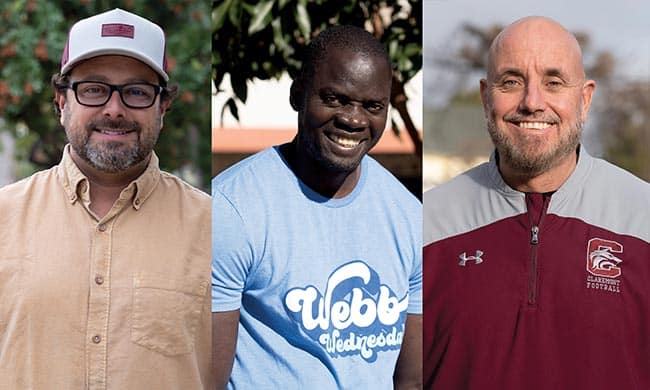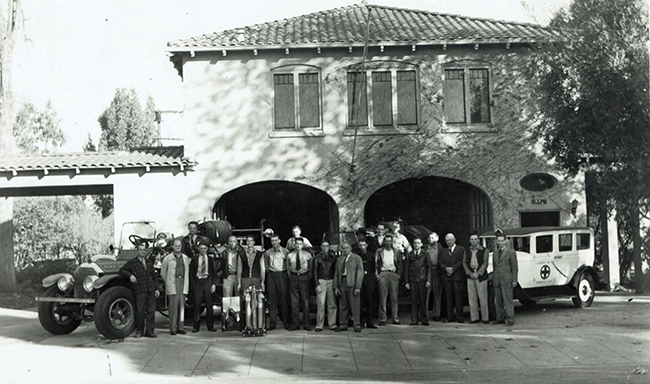Hamlin incident sparks local dialog on athlete safety

(L-R) Claremont High School varsity cross country coach Chris Ramirez, Webb Schools girls varsity soccer head coach Malick Mbengue, and CHS head varsity football coach Shane Hile. COURIER photos/Andrew Alonzo
by Andrew Alonzo | aalonzo@claremont-courier.com
With five minutes, 58 seconds left in the first quarter of Monday’s National Football League clash between the Buffalo Bills and Cincinnati Bengals, spectators were stunned when Bill’s safety Damar Hamlin collapsed on the field after he collided with Bengals wide receiver Tee Higgins.
Hamlin sprang up after the play but crumpled seconds later. Onsite medical teams quickly administered to the fallen player.
In a statement on Tuesday the Buffalo Bills said Hamlin suffered a cardiac arrest. His heartbeat was restored on the field before he was transferred to the University of Cincinnati Medical Center. At press time Thursday, Hamlin remained in critical condition.
It’s still unclear what caused Hamlin’s collapse. For a heart arrhythmia to occur, there has to be “a perfect storm” of factors, the New York Times reported this week. “The chest must be struck in a precise place at a precise moment while the heart is relaxing after squeezing out blood, and with the right amount of force.”

(L-R) Claremont High School varsity cross country coach Chris Ramirez, Webb Schools girls varsity soccer head coach Malick Mbengue, and CHS head varsity football coach Shane Hile. COURIER photos/Andrew Alonzo
The gruesome incident has sparked discussion among local high school coaches and the California Interscholastic Federation.
Claremont High School head varsity football coach Shane Hile said having appropriate medical staff at events is one key to ensuring athletes’ safety.
“We have our athletic trainers, we have doctors at the games, we have everything just like I saw in the game last night,” Hile said Tuesday. “Those are things that you want to have when you have a sporting event like that. I think they did a lot of good things last night.”
California Interscholastic Federation bylaw 2122.2 states “a licensed medical doctor or the primary health provider designated by the home team as team physician or team doctor shall be in attendance at all playoff games.”
Hile also said in order to prevent such horrific occurrences in the future, football basics like tackling must be instilled correctly at all levels.
“Invest the time teaching those fundamentals, especially with a sport like football,” Hile said. “Before we even get in the pads, we actually teach a lot about tackling, without contact. Once we get into pads, we teach the protocols on how to do it safely.
“One of the main things you stress is keep your head up, you don’t want neck injuries. [Tackling] is just something that always needs to be taught year in, year out. I don’t care how much experience a player has, we’re still going to teach them tackling like it’s their first time putting on pads. That’s the most you can do.”
Vivian Webb School’s varsity soccer coach Malick Mbengue said Monday’s incident reminded him that injuries can happen anywhere, anytime, and to anyone, adding coaches should be trained how to stabilize an individual when such emergencies occur.
“It’s super important that as coaches we are trained in dealing with situations like that when they happen,” Mbengue said. “They can literally happen anywhere. Just having somebody who’s there, trained and can jump in and help and do what’s necessary until professionals arrive, those few seconds of someone who knows what they’re doing can save somebody’s life.”
Claremont High School varsity cross country coach Chris Ramirez said Monday’s incident looked “really frightening,” and took him back to the start of the 2022 cross country season at the Cool Breeze Invitational.
“One of our athletes took a fall in the very beginning of the varsity boys race and was trampled by quite a few runners in a really large race,” Ramirez said. The runner got up and finished the race, but later learned he had suffered a concussion. It was the first time Ramirez had seen a CHS cross country athlete suffer a concussion during a race.
When it was time to ease the runner back into competition, Ramirez worked with CHS athletic trainer Jonathan Snapp to tailor its concussion protocol for cross-country runners. The plan involved easing the athlete back slowly using increasingly progressive timed intervals and plenty of oversight from Ramirez and Snapp.
“It was over a three-week period that he was able to return back to running in full training mode again,” Ramirez said.
While cross-country is viewed as a non-contact sport, recent events have prompted Ramirez to create new safety practices. Toward the end of this season when bigger invitationals began, the boys and girls teams practiced how to safely get out from the starting line since runners get physical there to get a good position.
“We’re going to put ourselves into these mock situations so that we are better able to react,” he said. “Of course, in a hit that went on last night, you can’t always react to that. It’s a different scenario but … something like that should drive coaches to look at how this might happen in their own sport and take proper measures to prevent it.
“Any sport can be scary like that. Even in track I’ve seen when they break in from their lanes people running into each other, and you’re running as fast as you can, so when you go down, you go down hard.”
According to the California Interscholastic Federation, sudden cardiac arrest is the number one killer of student athletes in the state. The CIF’s guidelines cover several sports medicine topics, including sudden cardiac arrest, and are viewable at cifstate.org/sports-medicine.
Other CIF bylaws that address student-athlete safety include 503 G – Physical examination; 503 H – Concussion protocol; 503 I – Steroid prohibition; 503 J – Sudden cardiac arrest protocol; 503 K – Heat illness protocol; 503 L – Emergency action plans and automated external defibrillator protocol; and 506 – Practice allowance. To view each bylaw in depth, visit the online version of this story at claremont-courier.com.
In 2017, the Eric Paredes Sudden Cardiac Arrest Prevention Act went into effect in California. The bill added SCA training to coaching certification, among other requirements.
Absent a concrete medical diagnosis as to why Hamlin collapsed, Monday’s incident left Ramirez with questions.
“You just don’t know what’s going on in that moment,” he said. “What is this type of injury? It’s just super scary and I would say it should make all coaches in sports think of how something like that may come about in their own sport and go ahead and practice new protocols.”










0 Comments